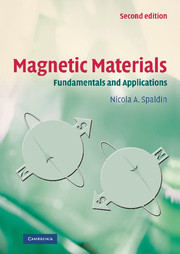Book contents
- Frontmatter
- Contents
- Acknowledgments
- I Basics
- 1 Review of basic magnetostatics
- 2 Magnetization and magnetic materials
- 3 Atomic origins of magnetism
- 4 Diamagnetism
- 5 Paramagnetism
- 6 Interactions in ferromagnetic materials
- 7 Ferromagnetic domains
- 8 Antiferromagnetism
- 9 Ferrimagnetism
- 10 Summary of basics
- II Magnetic phenomena
- III Device applications and novel materials
- Epilogue
- Solutions to selected exercises
- References
- Index
8 - Antiferromagnetism
from I - Basics
Published online by Cambridge University Press: 05 June 2012
- Frontmatter
- Contents
- Acknowledgments
- I Basics
- 1 Review of basic magnetostatics
- 2 Magnetization and magnetic materials
- 3 Atomic origins of magnetism
- 4 Diamagnetism
- 5 Paramagnetism
- 6 Interactions in ferromagnetic materials
- 7 Ferromagnetic domains
- 8 Antiferromagnetism
- 9 Ferrimagnetism
- 10 Summary of basics
- II Magnetic phenomena
- III Device applications and novel materials
- Epilogue
- Solutions to selected exercises
- References
- Index
Summary
A large number of antiferromagnetic materials is now known; these are generally compounds of the transition metals containing oxygen or sulphur. They are extremely interesting from the theoretical viewpoint but do not seem to have any applications.
Louis Néel, Magnetism and the Local Molecular Field, Nobel lecture, December 1970Now that we have studied the phenomenon of cooperative ordering in ferromagnetic materials, it is time to study the properties of antiferromagnets. In antiferromagnetic materials, the interaction between the magnetic moments tends to align adjacent moments antiparallel to each other. We can think of antiferromagnets as containing two interpenetrating and identical sublattices of magnetic ions, as illustrated in Fig. 8.1. Although one set of magnetic ions is spontaneously magnetized below some critical temperature (called the Néel temperature, TN), the second set is spontaneously magnetized by the same amount in the opposite direction. As a result, antiferromagnets have no net spontaneous magnetization, and their response to external fields at a fixed temperature is similar to that of paramagnetic materials – the magnetization is linear in the applied field, and the susceptibility is small and positive. The temperature dependence of the susceptibility above the Néel temperature is also similar to that of a paramagnet, but below TN it decreases with decreasing temperature, as shown in Fig. 8.2.
The first direct imaging of the magnetic structure of antiferromagnets was provided by neutron diffraction experiments. We will begin this chapter by reviewing the physics of neutron diffraction, and showing some examples of its successes.
- Type
- Chapter
- Information
- Magnetic MaterialsFundamentals and Applications, pp. 96 - 112Publisher: Cambridge University PressPrint publication year: 2010
- 1
- Cited by



